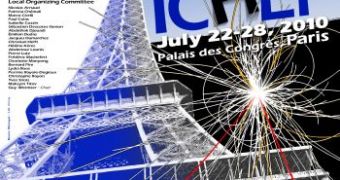The first results from the LHC at CERN are being presented at the 35th International Conference on High Energy Physics, the world’s largest international conference on particle physics, held this year in Paris. Representatives of the four experiments at the Large Hadron Collider – ALICE, ATLAS, CMS and LHCb- are presenting today measurements from the last three months of LHC operations at 3.5 TeV per beam, an energy three and a half times higher than previously obtained at a particle accelerator.
These first experiments allowed scientists to rediscover particles at the base of the Standard Model (theory describing the particles of matter and the forces that act between them). The LHC recorded billions of collisions and, for the first time in an European laboratory, some might be eligible for the truth quark, according to information from AlphaGalileo.
Rolf Heuer, director-General at CERN says: “Rediscovering our ‘old friends’ in the particle world shows that the LHC experiments are well prepared to enter new territory. It seems that the Standard Model is working as expected. Now it is down to nature to show us what is new.”
The LHC has achieved great performances and has furnished high quality data, and the results presented at the ICHEP prove it. Its operating conditions are continuously improving, and the measure of the collision rate has already risen more than a thousand times since the end of March.
“Within days we were finding Ws, and later Zs – the two carriers of the weak force discovered here at CERN nearly 30 years ago,” said 3000-strong ATLAS collaboration representative, Fabiola Gianotti. “Thanks to the efforts of the whole collaboration, in particular the young scientists, everything from data-taking at the detector, through calibration, data processing and distribution, to the physics analysis, has worked fast and efficiently.”
Guido Tonelli, spokesman for CMS said: “It is amazing to see how quickly we have ‘re-discovered’ the known particles: from the lightest resonances up to the massive top quark. What we have shown here in Paris is just the first outcome of an intense campaign of accurate measurements of their properties. This patient and systematic work is needed to establish the known background to any new signal.”
LHC scientists are very satisfied by the results of their work. “The LHCb experiment is tailor-made to study the family of b particles, containing beauty quarks, so it’s extremely gratifying that we are already finding hundreds of examples of these particles, clearly pin-pointed through the analysis of many particle tracks, ”added Andrei Golutvin, the experiment’s spokesperson.
The LHC will run for another 18 to 24 months at CERN, aiming to deliver much more data from the experiments. Future advancements should allow making new and exciting discoveries.

 14 DAY TRIAL //
14 DAY TRIAL //